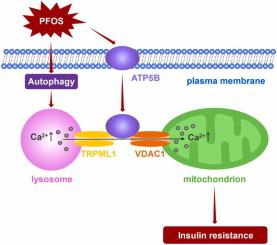当前位置:
X-MOL 学术
›
Ecotox. Environ. Saf.
›
论文详情
Our official English website, www.x-mol.net, welcomes your feedback! (Note: you will need to create a separate account there.)
Autophagy-dependent lysosomal calcium overload and the ATP5B-regulated lysosomes-mitochondria calcium transmission induce liver insulin resistance under perfluorooctane sulfonate exposure
Ecotoxicology and Environmental Safety ( IF 6.8 ) Pub Date : 2024-04-15 , DOI: 10.1016/j.ecoenv.2024.116318 Jixun Li , Yu Ma , Tianming Qiu , Jianyu Wang , Jingyuan Zhang , Xiance Sun , Liping Jiang , Qiujuan Li , Xiaofeng Yao
Ecotoxicology and Environmental Safety ( IF 6.8 ) Pub Date : 2024-04-15 , DOI: 10.1016/j.ecoenv.2024.116318 Jixun Li , Yu Ma , Tianming Qiu , Jianyu Wang , Jingyuan Zhang , Xiance Sun , Liping Jiang , Qiujuan Li , Xiaofeng Yao

|
Perfluorooctane sulfonate (PFOS), an officially listed persistent organic pollutant, is a widely distributed perfluoroalkyl substance. Epidemiological studies have shown that PFOS is intimately linked to the occurrence of insulin resistance (IR). However, the detailed mechanism remains obscure. In previous studies, we found that mitochondrial calcium overload was concerned with hepatic IR induced by PFOS. In this study, we found that PFOS exposure noticeably raised lysosomal calcium in L-02 hepatocytes from 0.5 h. In the PFOS-cultured L-02 cells, inhibiting autophagy alleviated lysosomal calcium overload. Inhibition of mitochondrial calcium uptake aggravated the accumulation of lysosomal calcium, while inhibition of lysosomal calcium outflowing reversed PFOS-induced mitochondrial calcium overload and IR. Transient receptor potential mucolipin 1 (TRPML1), the calcium output channel of lysosomes, interacted with voltage-dependent anion channel 1 (VDAC1), the calcium intake channel of mitochondria, in the PFOS-cultured cells. Moreover, we found that ATP synthase F subunit beta (ATP5B) interacted with TRPML1 and VDAC1 in the L-02 cells and the liver of mice under PFOS exposure. Inhibiting ATP5B expression or restraining the ATP5B on the plasma membrane reduced the interplay between TRPML1 and VDAC1, reversed the mitochondrial calcium overload and deteriorated the lysosomal calcium accumulation in the PFOS-cultured cells. Our research unveils the molecular regulation of the calcium crosstalk between lysosomes and mitochondria, and explains PFOS-induced IR in the context of activated autophagy.
中文翻译:

全氟辛烷磺酸暴露下自噬依赖性溶酶体钙超载和 ATP5B 调节的溶酶体-线粒体钙传输诱导肝脏胰岛素抵抗
全氟辛烷磺酸(PFOS)是一种官方列出的持久性有机污染物,是一种分布广泛的全氟烷基物质。流行病学研究表明,PFOS与胰岛素抵抗(IR)的发生密切相关。然而,详细机制仍不清楚。在之前的研究中,我们发现线粒体钙超载与PFOS引起的肝脏IR有关。在这项研究中,我们发现 PFOS 暴露从 0.5 小时起就显着升高了 L-02 肝细胞中的溶酶体钙。在 PFOS 培养的 L-02 细胞中,抑制自噬可缓解溶酶体钙超载。抑制线粒体钙摄取加剧了溶酶体钙的积累,而抑制溶酶体钙流出则逆转了PFOS诱导的线粒体钙超载和IR。在 PFOS 培养的细胞中,瞬时受体电位粘脂蛋白 1 (TRPML1)(溶酶体的钙输出通道)与电压依赖性阴离子通道 1 (VDAC1)(线粒体的钙摄入通道)相互作用。此外,我们发现 ATP 合成酶 F 亚基 beta (ATP5B) 与 PFOS 暴露下的 L-02 细胞和小鼠肝脏中的 TRPML1 和 VDAC1 相互作用。抑制 ATP5B 表达或抑制质膜上的 ATP5B 可减少 TRPML1 和 VDAC1 之间的相互作用,逆转线粒体钙超载并恶化 PFOS 培养细胞中的溶酶体钙积累。我们的研究揭示了溶酶体和线粒体之间钙串扰的分子调节,并解释了 PFOS 在激活自噬过程中诱导的 IR。
更新日期:2024-04-15
中文翻译:

全氟辛烷磺酸暴露下自噬依赖性溶酶体钙超载和 ATP5B 调节的溶酶体-线粒体钙传输诱导肝脏胰岛素抵抗
全氟辛烷磺酸(PFOS)是一种官方列出的持久性有机污染物,是一种分布广泛的全氟烷基物质。流行病学研究表明,PFOS与胰岛素抵抗(IR)的发生密切相关。然而,详细机制仍不清楚。在之前的研究中,我们发现线粒体钙超载与PFOS引起的肝脏IR有关。在这项研究中,我们发现 PFOS 暴露从 0.5 小时起就显着升高了 L-02 肝细胞中的溶酶体钙。在 PFOS 培养的 L-02 细胞中,抑制自噬可缓解溶酶体钙超载。抑制线粒体钙摄取加剧了溶酶体钙的积累,而抑制溶酶体钙流出则逆转了PFOS诱导的线粒体钙超载和IR。在 PFOS 培养的细胞中,瞬时受体电位粘脂蛋白 1 (TRPML1)(溶酶体的钙输出通道)与电压依赖性阴离子通道 1 (VDAC1)(线粒体的钙摄入通道)相互作用。此外,我们发现 ATP 合成酶 F 亚基 beta (ATP5B) 与 PFOS 暴露下的 L-02 细胞和小鼠肝脏中的 TRPML1 和 VDAC1 相互作用。抑制 ATP5B 表达或抑制质膜上的 ATP5B 可减少 TRPML1 和 VDAC1 之间的相互作用,逆转线粒体钙超载并恶化 PFOS 培养细胞中的溶酶体钙积累。我们的研究揭示了溶酶体和线粒体之间钙串扰的分子调节,并解释了 PFOS 在激活自噬过程中诱导的 IR。



























 京公网安备 11010802027423号
京公网安备 11010802027423号